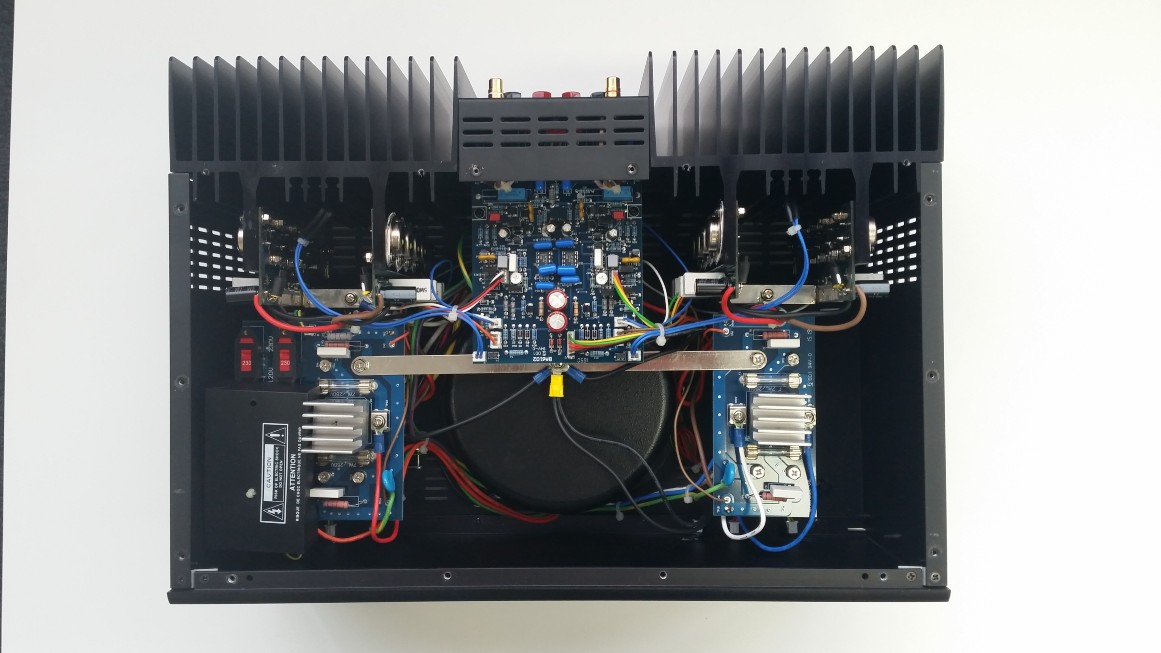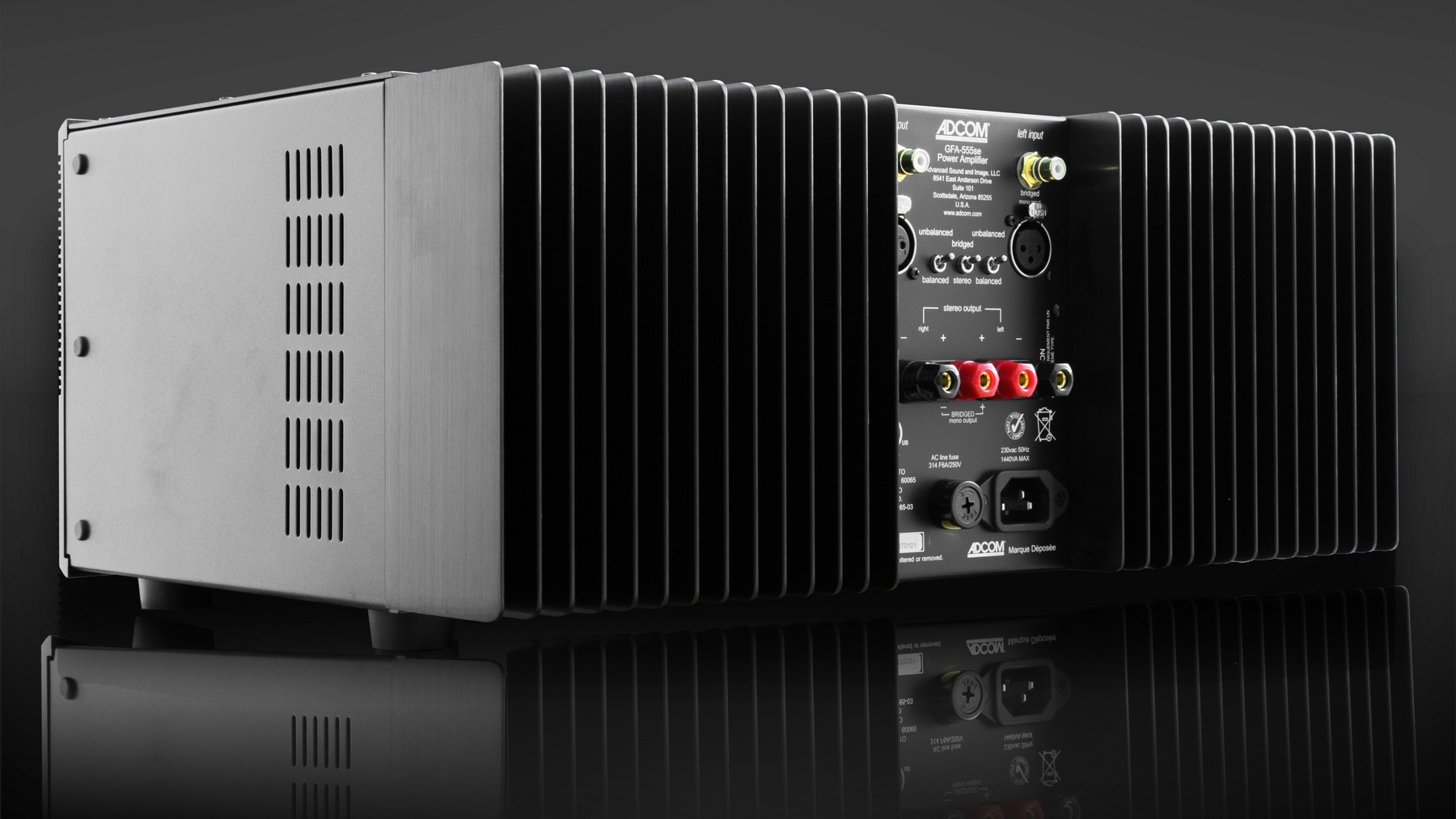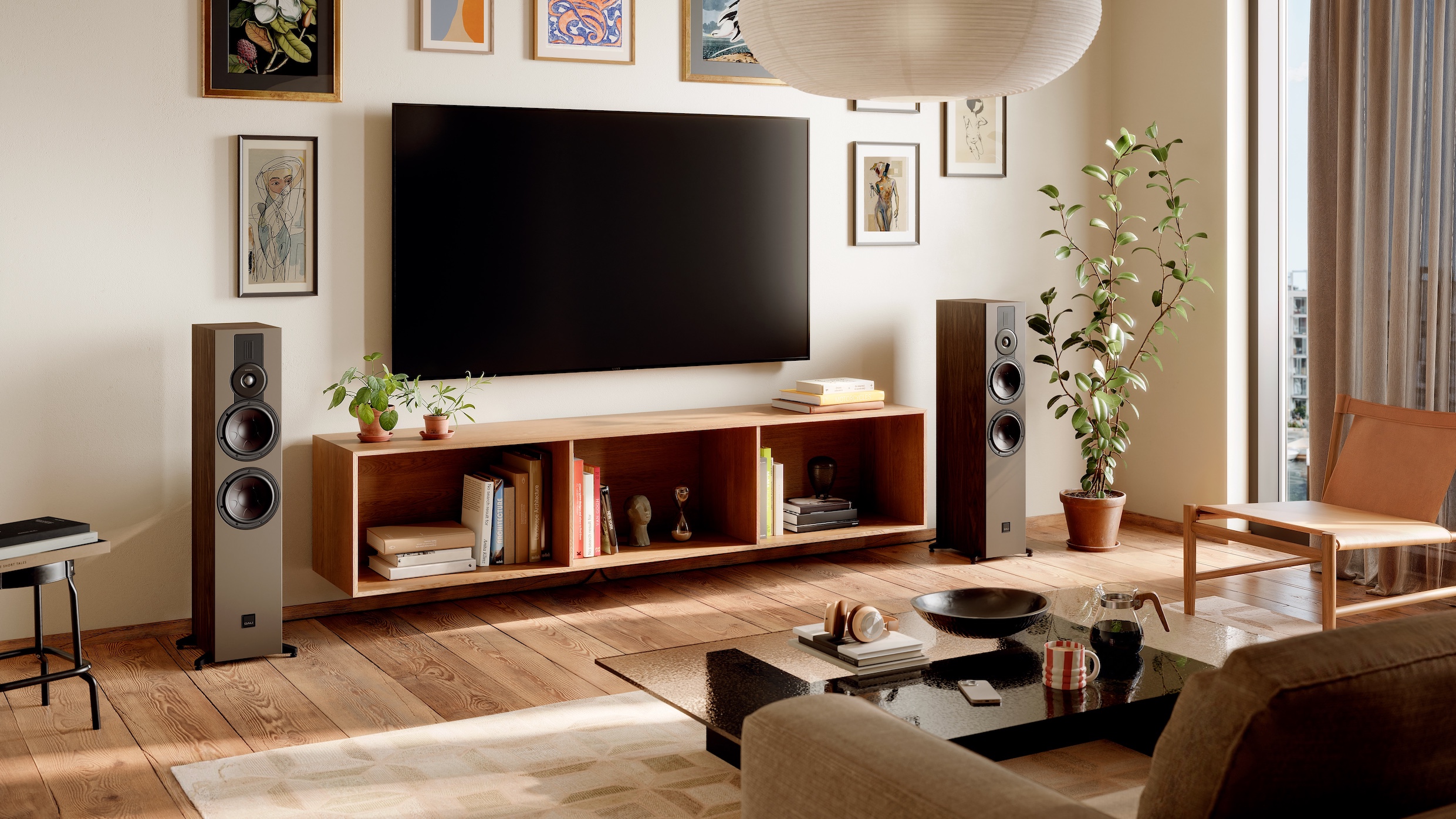What Hi-Fi? Verdict
The Adcom GFA-555se may lack a few of the circuit niceties that are now part and parcel on modern amplifier designs, but it punches so far above its weight when it comes to must-haves, such as high power and low noise and distortion, that it deserves a place on a shortlist.
Pros
- +
Very high power
- +
Great sound
- +
Low noise
Cons
- -
No protection circuitry
- -
No standby mode
Why you can trust What Hi-Fi?

This review and test originally appeared in Australian Hi-Fi magazine, one of What Hi-Fi?’s sister titles from Down Under. Click here for more information about Australian Hi-Fi, including links to buy individual digital editions and details on how best to subscribe.
The Adcom GFA-555se is an evolution of an amplifier that, shortly after it was released in March 1985, became not only Adcom’s best-selling and most famous model but also one of the most famous amps of the last century. Reviewer Anthony Cordesman, who reviewed it at the time for Stereophile magazine, said: “It is so clearly superior to past amplifiers in the low-to-mid-priced range – not to mention most amplifiers costing two to three times its price – that I can unhesitatingly recommend it for even the most demanding high-end system.”
That the Adcom GFA-555 should have been successful was no surprise to anyone working in audio electronics back in the ‘80s, because the then-owner of Adcom, Alec Chenin, who had taken over the reins when his father Newt (also Adcom’s founder) retired, had dispensed with the services of the designers his father had used (Morris Kessler and Ed Miller) and instead hired those of the-then young (34-years-old) wunderkind designer Nelson Pass. Pass had made his name at Threshold and in 1991 would go on to found Pass Labs, which he continues to front to this day.
Despite the success of the GFA-555 (the initials stand for ‘Great F**cking Amplifier’, by the way), Adcom was taking a hit on warranty returns for it, because for some reason they had decided not to use the specific driver transistors Pass had specified (Motorola MJE15030/31 pairs) and instead had substituted 2SA1011/2SC2344 transistors. This worked fine unless the speaker protection fuses went open-circuit to protect the output transistors, in which case they failed. The problem became so well-known amongst audiophiles that the company decided to build a ‘mark II’ version of the GFA-555 that used the correct driver transistors and sported an updated look over the previous exterior design, which was straight out of the ‘70s. This more modern aesthetic has certainly stood the test of time, being essentially the same the company now uses across its current amplifier range.
As for how this new GFA-555se differs from the original GFA-555 or, indeed, the subsequent GFA-555MkII, I cannot really say, not least down to the fact that Adcom made quite a few running changes to the internal circuitry of both versions whilst keeping the model numbers unchanged. It may be that this ‘se’ variant incorporates the best mods made for both models. What I can tell you is that Adcom is no longer owned by Alec Chenin, nor is it still manufactured in the USA in the same factory that once built amplifiers not only for Adcom but also for Theta Digital and others. It’s now owned by Everest World Company Ltd., a company based in Bangkok, Thailand, that subcontracts its manufacturing out to specialist factories in Taiwan and China.

Design & features
What I can also relay is what Adcom has said is new in this ‘se’ version: “Internally, all circuitry has been upgraded to meet ETL/ETLc, FCC, LVD and CE/EMC requirements using UL approved FR-4 printed circuit boards. High-performance component selections include ultra-low ESR electrolytic capacitors. The result of these improvements is lower distortion, better dynamic range, improved damping factor and greater stability and separation of individual instruments on the sound stage.” The output transistors are MJ15022/23 pairs (four pairs per channel). These are very beefy devices, rated for 16-amp/250-watt operation.
Something the Adcom GFA-555se does share with all of its predecessors is that it is, at its core, a ‘bare-bones’ power amplifier. You are not able to control the volume on the amplifier itself, with either a single volume control or a pair of them, and you don’t get any real indication of how much power it might be delivering to your loudspeakers at any given instant because there are neither LED power indicators nor output level meters.
That said, you will get an indication of when the output stage has reached its maximum output and started to clip, as Adcom has included its clumsily-named “advanced power amplifier instantaneous distortion alert” circuitry in the Adcom GFA-555se. Essentially, these LEDs simply light to show output stage clipping, though Adcom dresses this up somewhat by claiming that the circuit is “a unique Adcom distortion-detection system which reads all forms of non-linear distortion such as THD, IM, slew-induced ‘clipping’, etc. The instantaneous distortion alert LEDs will light when distortion reaches 1 per cent regardless of the impedance or the phase angle of the current voltage and the reactance of the loudspeakers which the amplifier is driving. Sometimes, when the amplifier is in use, the LEDs may occasionally flicker under high-volume listening, particularly if you are driving low impedances. This flickering is no cause for concern. The LEDs are simply warning you that the amplifier is approaching its maximum power output into the specific loudspeakers which you are using. If, however, the instantaneous distortion alert LEDs glow brightly or are on most of the time during playback, you are overdriving the amplifier and should lower the volume control to reduce the listening-level demands, or you may blow the AC rail fuses, cause the thermal protection to be activated or, in extreme cases, damage your loudspeakers.”
The latest hi-fi, home cinema and tech news, reviews, buying advice and deals, direct to your inbox.
All of this information is completely true and totally accurate, but that is because when any amplifier is clipping, that clipping will introduce non-linear distortions such as THD and IMD, so the circuit is not actually detecting increases in THD or IMD per se – or even slew rate limiting – but is instead showing that the voltage required by the output stage has exceeded the amplifier’s rail voltage.
Immediately to the right of the L and R ‘distortion alert’ LEDs is an LED labelled ‘thermal’, which will shut down the output stage of the amp if the temperature of either the left-channel or right-channel heat sink reaches 75°C. In that case, you’ll hear no sound from your loudspeakers until the temperature of the heat sinks drops below that figure, after which the amplifier will automatically re-connect the output stage and playback will continue. (There is also a thermal cut-out circuit in the main toroidal transformer, though this is set to such a high temperature – 125°C – that if it triggers, you’re doing something fundamentally wrong!).
Immediately to the right of the ‘thermal’ LED is an LED labelled ‘limit’. You will see this turn on for around ten seconds whenever you switch the amp on while the circuitry stabilises, after which you’ll hear a pair of relays click to signify that the amplifier is ready for use.

Unlike most high-power power amplifiers, the Adcom GFA-555se does not have overload protection circuitry to protect it in the event that you, say, accidentally short-circuit the positive and negative terminals, or inadvertently connect the positive terminal to ground – which could happen if you used some types of active subwoofer in conjunction with the amplifier. Due to this, I would not recommend connecting anything to the GFA-555se’s speaker outputs other than conventional passive loudspeakers. I’d further recommend that you double-check all speaker wiring before turning the power on, and that if you wish to make any changes to the
wiring (input or output!) you always turn the amp off before doing so. Note that in saying this, I do not wish to imply that I am specifically singling out the GFA-555se with this advice – I would make the same recommendation for all audio amplifiers.
That said, I would have preferred it if Adcom had incorporated some type of electronic protection to guard against short circuits. After all, if you do accidentally short-circuit the output, it will make for a very expensive repair!
The only other feature on the front panel is the mains power switch, which is actually a ‘mains’ power switch as opposed to a standby switch. Unlike some Adcom models, which have auto-sensing circuitry to switch the amplifier on automatically when it senses an audio signal at its input, and to standby when it has not detected a signal for a period of time, the GFA-555se remains ‘on’ all the time. Because of this, I would strongly recommend turning the GFA-555se off whenever you are not using it.
Around the back of the amplifier is a centrally-located connection panel that offers both unbalanced (via gold-plated RCA terminals) and balanced (via gold-plated XLR terminals) inputs, with two micro-switches (one for each channel) to select the pair you are using. Use only one or the other of these two inputs (i.e. balanced or unbalanced) and do not move either of the switches if the amplifier is switched on or has only recently been turned off. (I’d wait 15 minutes before switching.)
The Adcom GFA-555se can be operated as a conventional stereo amp, in which configuration it is rated as delivering 200 watts per channel into 8-ohm loads and 300 watts per channel into 4-ohm loads. However, you can also ‘bridge’ the left and right channels together to turn the GFA-555se into a single-channel (mono) amp, in which configuration it is rated with a power output of 600 watts. If you decide to operate the amplifier in this mode, however, know that you will double the amplifier’s intrinsic distortion (from 0.04 to 0.08 per cent), you will reduce its damping factor by half, and you will be restricted to using loudspeakers whose nominal impedance does not drop below 4 ohms.
Note too that if you choose to use the Adcom in its bridged mono mode, you will need to use a different speaker wiring configuration and move the micro-switch between the two input selector switches from the ‘stereo’ position to the ‘bridged’ one. As I stated earlier, all wiring changes and switch position changes should be made only after the amplifier has been switched off (and preferably also when the amplifier is completely disconnected from mains power).

Performance
The immense power on tap and the solidity of the GFA-555se’s low-frequency performance was in plain sight from the moment the first notes of the first track of Self Esteem’s 2021 masterpiece, ‘Prioritise Pleasure’, burst forth from my speakers. That track (I’m Fine) has an underlying – almost subterranean – rumble that is so complex that many amplifiers just can’t make it sound like it should. I’m happy to report that the GFA-555se had no such issues, delivering the sound wonderfully well.
The Adcom also delivered all the different sound effects Rebecca Taylor has added to her voice on this track in such a way that you can hear the underlying vocal artistry, and the clarity when she sings without them then hits you like a bolt of lightning. All of this fidelity also serves to enhance the message of the lyrics, which was powerfully relevant in 2021 and is even more so given the goings-on this year.
Given the meaning of the ‘F’ in GFA, it was almost serendipitous that the second track of ‘Prioritise Pleasure’ is titled Fucking Wizardry, but when I heard how crisply the GFA-555se was delivering the percussion, clicks and transients of this superb song, I forgot this and instead settled in for the pure aural enjoyment of the experience. This is a beautifully constructed song that sounds fantastic on good hi-fi systems.
Listening to Hobbies 2, I was impressed by how clearly the Adcom was able to render Taylor’s voice in an echo-less acoustic while at the same time deliver the super-deep infra-bass and the crisp high-frequency sounds intrinsic in the track. When the sound suddenly disappears totally around 2.40 minutes in, the instantaneous though brief silence is so silent that it is actually shocking, proving to me that the Adcom is not only a powerful amplifier but also a quiet one.
Taylor is a dab hand with a lyric, as every song of that album is evidence of, and the intro to the title track is all the proof you need. I literally laughed out loud the first time I heard her sing ‘Listen to my body/We haven’t been in touch much lately’, and the line still brings a smile to my face every time I play the album, which is often. Taylor is equally great with her lyrics to the album’s money track, I Do This All the Time. When she speaks the lyric ‘Be very careful out there - Stop trying to have so many friends - Don’t be intimidated by all the babies they have - Don’t be embarrassed that all you’ve had is fun - Prioritise pleasure - Don’t send those long paragraph texts - Stop it, don’t’, you understand that her ability to write about what affects us as humans is as impressive as her musical creativity. Listen, too, to the way she has mixed live audience sounds into this track – audience sounds that have nothing to do with her audience – and the superb control over echo and reverb. I also love the words and sound of the choral chorus: ‘So look up, lean back, be strong - You didn’t think you’d live this long.’
The two channels of the Adcom GFA-555se are beautifully balanced, as you will most definitely hear if you listen to Arlo Parks’ joyous album ‘Collapsed in Sunshine’. On the track Hurt, for example, the stereo image that this amplifier is able to create is not only realistic but also completely stable. Listen also to how the timbral accuracy of the amplifier renders Parks’ unique voice instantly recognisable. The string sound on Black Dog is also something to write home about – as are many of the lines, ‘I’d lick the grief right off your lips’ being one such standout.
Verdict
The Adcom GFA-555se may lack a few of the circuit niceties that are now part and parcel on modern amplifier designs – such as a standby circuit, for one – but it punches so far above its weight when it comes to must-haves such as high power, low noise, low distortion, extraordinary extended frequency response and, of course, superb sound, that it deserves to be included on the ‘must-listen list’ of anyone in the market for high-quality, high-fidelity power amplification.
MORE:
Read more Australian Hi-Fi news, reviews and features
Join us at the Australian Hi-Fi Show 2023 in Sydney! Tickets on sale now
Australian Hi-Fi is one of What Hi-Fi?’s sister titles from Down Under and Australia’s longest-running and most successful hi-fi magazines, having been in continuous publication since 1969. Now edited by What Hi-Fi?'s Becky Roberts, every issue is packed with authoritative reviews of hi-fi equipment ranging from portables to state-of-the-art audiophile systems (and everything in between), information on new product launches, and ‘how-to’ articles to help you get the best quality sound for your home.
Click here for more information about Australian Hi-Fi, including links to buy individual digital editions and details on how best to subscribe.


